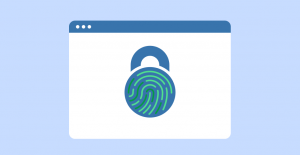Key takeaways:
- FQDNs offer convenience and organizational benefits.
- FQDNs are complete and specific address of a server.
- FQDNs help clearly identify resources on the internet without confusion.
A key part of leveraging the internet for brand marketing is domain names, which serve as the online address for websites. Fully qualified domain names (FQDNs) stand out as a cornerstone of internet navigation and website identity.
In this guide, you’ll learn what FQDN is, what it means, how it differs from other domain types, and how to find one on your device or server.
What is a fully qualified domain name (FQDN)?
A fully qualified domain name (FQDN), also known as an absolute domain name, is the complete and specific address of a server or host on the internet. The word qualified means that the domain name is fully specified—it can be uniquely identified without needing more information. Think of it as the full mailing address of an online location. Just as your home address includes your house number, street, city, and zip code, an FQDN encompasses every part of the domain, ensuring an exact and unique destination.
For instance, in the FQDN “mail.example.com,” “mail” is a subdomain of “example.com,” forming a complete path to the specific mail server under the “example.com” domain.
What are the elements of an FQDN?
Every FQDN consists of several parts that form its hierarchy within the Domain Name System. It has a complete domain name that includes:
- Top-level domain
- Second-level domain
- Subdomain
- Hostname
Top-level domain
The top-level domain, also known as TLD, is the last part of a complete domain name. It comes after the dot (.).
For example, in www.blog.example.com, .com is the TLD. Other examples of TLDs are:
- .org
- .net
- .shop
Second-level domain
The second-level domain sits directly before the TLD. It’s usually the name of the business or organization that owns the domain.
In the example www.blog.example.com, example is the second-level domain.
Subdomain
The subdomain comes before the second-level domain. So, in www.blog.example.com, blog is the subdomain.
Subdomains help divide the main website into sections, each pointing to a specific page on the website.
Hostname
Hostnames appear in the leftmost part of the FQDN. You’ll see it after the http:// or https:// of a web address. It identifies the server connected to a network.
For example:
- www for web servers
- mail for mail servers
- ftp for file transfer servers
How an FQDN works
Each time you search online, your device sends and receives packets of data across different servers. It’s a fast process.
To achieve this, every web server or device is assigned a corresponding IP address, a set of numbers that enables your device to interact with others. Why? Because computers don’t process words, they rely on numerical data.
When you enter a domain like NetworkSolutions.com, your web server checks to see if any records for Network Solutions are already in your cache; if not, it directs your query elsewhere.
This is where the Domain Name System (DNS) plays its part. When you enter a website address, your device translates that FQDN into a numerical IP address through the DNS. This allows computers to communicate efficiently and quickly identify a site’s IP address, while users can base on human-readable domain names.
Instead of typing a complex string like 172.64.145.59, you can enter the FDQN into a web browser, and the DNS will handle the lookup for you. You can also perform a reverse DNS lookup to find the FQDN associated with a specific IP address.
Examples of FQDN in real life
A well-thought-out and organized FQDN can bring benefits like improved security and brand cohesion. Here are some more examples to illustrate their structure and diversity:
| Server type | FQDN example | Subdomain (s) | Second-level domain | Top-level domain (TLD) | Purpose |
|---|---|---|---|---|---|
| Web server | www.example.com | www | example | .com | Points to the main web server of the example.com domain. |
| Mail server | mail.company.org | company | .org | Accesses the email server of company.org. | |
| FTP server | ftp.archive.net | ftp | archive | .net | Used for file transfers via FTP for archive.net. |
| Database server | db1.internal.example.com | db1, internal | example | .com | Accesses a specific database server within the internal network. |
| API server | api.service.example.co.uk | api, service | example | .co.uk | Points to an API server for service.example.co.uk. |
| Cloud service | cloud-storage.enterprise.com | cloud-storage | enterprise | .com | Leads to a cloud storage service for enterprise.com. |
| Educational institution | student.portal.university.edu | student, portal | university | .edu | Represents a student portal of university.edu. |
| Government Website | services.department.gov.us | services | department | .gov.us | Points to a specific service of a U.S. government department. |
How FQDN is different from PQDN
Partially qualified domain names, or PQDNs, refer to a shortened form of a domain name, often leaving out sections like subdomains or the top-level domain (TLD). For example, using “example” instead of the full “www.example.com” would be considered a PQDN. Within internal networks or specific environments, PQDNs offer convenience.
But, outside of those closed systems, PQDNs lack the clarity and accuracy of fully qualified domain names (FQDNs). This can result in confusion or ambiguity across the broader internet, where precise identification is essential.
Technical insights: FQDN vs. PQDN
FQDNs are key for a globally unambiguous identification of internet resources, ensuring each address leads to a unique location. PQDNs, while useful in localized settings, might result in confusion or misdirection when used in a broader context. For businesses seeking a robust online presence, FQDNs offer the reliability and specificity needed for effective digital operations.
Troubleshooting and best practices
Even with a properly configured FQDN, issues can arise that prevent it from resolving correctly. Here are some common troubleshooting steps and best practices to ensure your FQDN functions smoothly and remains SEO-friendly:
- Check your DNS records
- Use diagnostic tools
- Validate subdomain configuration
- Avoid unnecessary redirects
- Secure your FQDN with HTTPS
Check your DNS records
If your FQDN isn’t resolving, start verifying your DNS records. The most critical ones include:
- A Record. Maps your domain to an IP address. Ensure it points to the correct server.
- CNAME Record. Used for aliasing one domain to another. Make sure it’s not misconfigured or pointing to an inactive domain.
Use tools like MXToolbox or your domain registrar’s DNS management dashboard to inspect and update these records.
Use diagnostic tools
Command-line utilities can help pinpoint where the resolution is failing. These tools can help identify whether the issue lies with your DNS provider, your server, or somewhere in between:
- ping. Quickly checks if the domain is reachable and measures response time
ping yourdomain.com - dig +trace. Offers a deeper look into the DNS resolution path, showing each step from the root servers to your domain.
dig +trace yourdomain.com Validate subdomain configuration
If you’re using subdomains (blog.yourdomain.com or shop.yourdomain.com), ensure each has its own properly configured DNS records. Missing or incorrect entries can lead to broken links, inaccessible pages, and poor user experience.
Tip: Use a wildcard DNS record (*.yourdomain.com) if you plan to host multiple subdomains and want a catch-all solution.
Avoid unnecessary redirects
Redirects can be useful, but excessive or poorly configured redirects can:
- Slow down page load times
- Confuse search engine crawlers
- Negatively impact SEO rankings
Stick to 301 redirects for permanent changes and minimize redirect chains. Use tools like Redirect Checker to audit your domain’s redirect paths.
Secure your FQDN with HTTPS
Always use SSL certificates to secure your domain. Not only does HTTPS protect user data, but it’s also a ranking factor in Google’s search algorithm. Check your domain registrar or web hosting provider to see if their plans include SSL certification.
What are the benefits of using FQDNs?
FQDNs offer numerous benefits, notably in terms of convenience and organization. They are easier to remember and use than numerical IP addresses, providing a user-friendly way to access websites.
Additionally, FQDNs allow for clear segregation of different services under one domain, like differentiating “shop.example.com” from “blog.example.com.” This segmentation enhances the user experience by directing them to the appropriate service.
Here are other benefits of using FQDNs.
To get SSL certificates
FQDNs play a role in Secure Sockets Layer (SSL) certificates. Certificate authorities (CAs) issue these certificates, which secure and encrypt data between a user and a website, to websites with a valid FQDN. This requirement underscores the importance of FQDNs in establishing secure, trustworthy online interactions, which are a must-have for any eCommerce or data-sensitive website.
To optimize your website
Proper use of FQDNs can indirectly enhance your website’s effectiveness and SEO performance. By choosing a clear, descriptive FQDN, you make your site more accessible and memorable to your audience.
How to find an FQDN
FQDNs aren’t limited to websites only. Your device also has its full name. To locate them, here’s how:
For Windows users
- On the Start menu, search and click View your PC name.
- In the Related links row, click Advanced system settings.
You’ll see FQDN in the Full Computer Name field.
For macOS users
- Navigate the Apple menu and click Settings.
- Click Sharing.
- Scroll down to the Local hostname section to see your FQDN.
For Linux users
- Press CTRL + ALT + T to open the Terminal app.
- Enter hostname –fqdn
Frequently asked questions
FQDN specifies a website’s location in the Domain Name System. On the other hand, the URL, Uniform Resource Locator, contains the protocol, like HTTP, and the path, along with the FQDN. FQDN is a subset of a URL.
No. FQDN is a full, human-readable address, while an IP address is a set of numbers that computers use to find websites. The DNS resolves the FQDN to its corresponding IP address.
A valid example of an FQDN is a web address containing the subdomain, second-level, and top-level domains, such as www.networksolutions.com.
Using FQDN for digital success
Understanding and utilizing FQDNs is beyond being a technical requirement; it’s a strategic step toward establishing a strong, recognizable online presence. As we’ve explored, the benefits of FQDNs range from improved navigation and organization to enhanced security.
With its comprehensive suite of digital solutions, Network Solutions is ready to assist you in navigating this aspect of your journey to success. Use our domain name search tool to find the perfect domain name for your brand!




